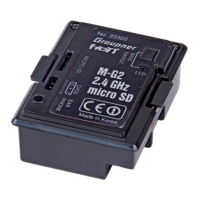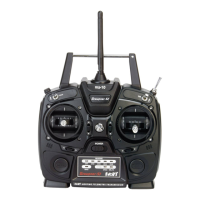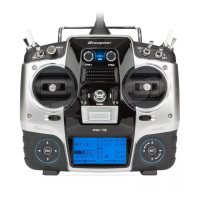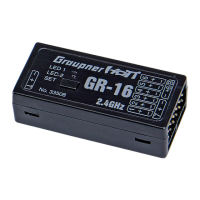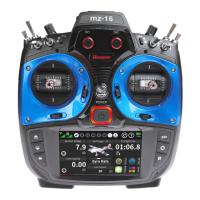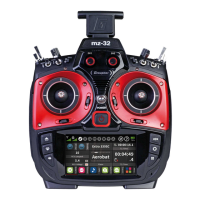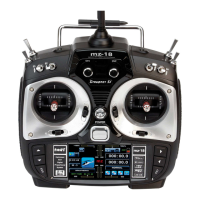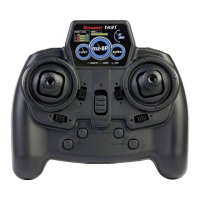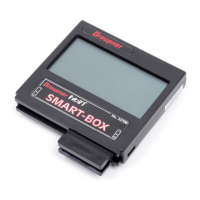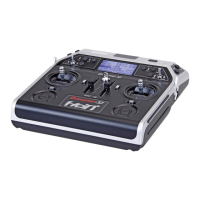if you call up the Fail-Safe function using the programming button as described below, this resets ALL
the settings of the SMART-BOX at the Fail-Safe screen (RX FAIL SAFE) - and this includes the settings
available through the facilities of the programming button. At the same time the Country setting will
revert to Universal if you have previously selected “France” using the programming button - see below
under “2.4”. You MUST therefore select the Country setting again if necessary. For this reason, where-
ver possible it is always best to maintain your programmed settings using the SMART-BOX.
Switch your receiving system on. Locate the BIND / RANGE button on the back of the transmitter, and
hold it pressed in while you switch the transmitter on. Release the button again once it is switched on.
You can now call up the desired Fail-Safe mode (Fail-Safe on / off, Hold, or Standard) by cycling through
the modes with a brief press of the BIND / RANGE button:
• Fail-Safe mode: when you press the BIND / RANGE button, the transmitter beeps once; the red
and green LEDs glow constantly.
It is now possible to program positions to which the servos will move in a Fail-Safe situation; this
occurs after a “Hold” period of 0.75 seconds: move the corresponding transmitter controls (sticks,
rotary knobs, INC / DEC buttons etc.) to the desired Fail-Safe positions SIMULTANEOUSLY, then
hold the BIND / RANGE button pressed in for three to four seconds. When you release the button,
both the red and green LEDs should light up constantly, and the transmitter should not emit an au-
dible signal: the transmitter now reverts to Control mode. If this does not occur, repeat the procedu-
re.
• Hold mode (recommended for model helicopters): when you press the BIND / RANGE button,
the transmitter beeps twice; the red LED lights up constantly, and the green LED goes out (factory
default setting).
If interference occurs, all servos programmed to “Hold” remain at the last position detected by the
receiver as correct; this situation is maintained until such time as the receiver picks up a new, valid
control signal.
You can save your selection by holding the BIND / RANGE button pressed in for three to four se-
conds. When you release the button, both the red and green LEDs should light up constantly, and
the transmitter should not emit an audible signal: the transmitter now reverts to Control mode. If this
does not occur, repeat the procedure.
• Fail-Safe OFF: when you press the BIND / RANGE button, the transmitter beeps three times; the
green LED glows constantly, the red LED goes out.
You can save your selection by holding the BIND / RANGE button pressed in for three to four se-
conds. When you release the button, both the red and green LEDs should light up constantly, and
the transmitter should not emit an audible signal: the transmitter now reverts to Control mode. If this
does not occur, repeat the procedure.
• Standard mode (suitable for fi xed-wing model aircraft only): when you press the BIND / RAN-
GE button, the transmitter beeps four times; both LEDs are off.
In this mode the throttle servo (channel 1) moves to the Fail-Safe position, i.e. the position you have
programmed for a Fail-Safe situation, while all the other channels remain at “Hold”.
Move the throttle stick to the desired position, then hold the BIND / RANGE button pressed in for
three to four seconds. When you release the button, both the red and green LEDs should light up
constantly, and the transmitter should not emit an audible signal: the transmitter now reverts to
Control mode. If this does not occur, repeat the procedure.
2.4. Range warning
If the receiver signal in the down-link channel becomes too weak, the transmitter always generates an
audible range warning in the form of a beep emitted about once per second. Since the transmitter’s
output is much higher than that of the receiver, you will still maintain full control of the model, but in the
interests of safety you should fl y the model back towards you until the warning signal ceases again.
If the audible range warning signal does not cease when you reduce the distance, then the transmitter
or receiver low voltage or temperature warning is active! In this case you must land the model and cease
operations without delay.
2.5. Firmware update or SMART-BOX connection
The SMART-BOX is connected to the DATA socket on the back of the transmitter.
Getting Started Graupner HoTT 2.4 03
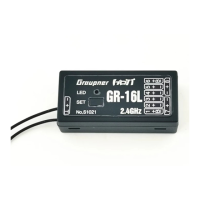
